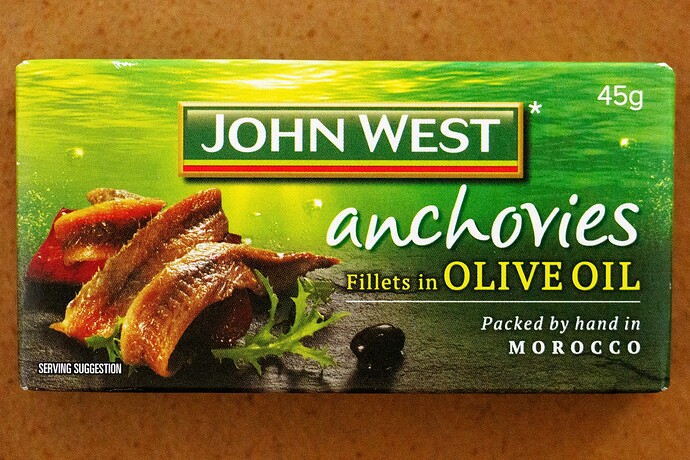The photo below is of a tin of anchovies of the familiar “John West” brand. On the bottom right, it states,
"Packed by hand in
“MOROCCO”
While most likely factual, I’m not sure if I find that statement reassuring or not. What do others think?
Then, on the side of the packet it states,
“Packed in Morocco from imported ingredients.”
So, we have no idea where the anchovies come from. All we know is that they were packed by hand in Morocco. Packing fermented fish by hand in a country with maybe dubious food processing laws, sounds fishy in itself (pardon the pun).
Global food supply chains at work.
As noted by Wikipedia
John West Foods is a United Kingdom-based seafood marketing company established in 1857, and currently owned by Thai Union Group of Thailand. The company produces canned salmon and tuna, as well as mackerel, sardine, herring, brisling, anchovies and shellfish.
There are a few similar topics about ‘packed’ and where ingredients are sourced, including labelling issues.
Are you aware, in spite of NZ reputation, many food items we source from NZ are from (eg) China, processed or packed in NZ? Without getting into one’s perception of where and what constitutes confidence, as @mark_m shows it is a global business and foods can come from many sources with numerous processes in many places.
The main constant for ‘trust’ is the brand overseeing all of their suppliers and factories regardless of local standards and laws, including the absence thereof.
I have very little issue with where the product was packed, or produced. My reasoning follows:
The Company would have strong contractual requirements about safe food handling. What protects us is firstly that many of the businesses have quality control systems in place, and they do not want to lose markets due to poor quality product causing litigation and that subsequent loss of faith in their products. Many of these Countries are chosen purely because the labour cost and labour laws to do the tedious, repetitive, mundane, work is much cheaper and easier than many “First World” places. Mechanical sorting of things like fish product for canning could lead to inferior product being chosen as discernment of blemish by machines can be hard to control and program for. AI may eventually lead to reduced need for human intervention.
As others have said about the globalised food chain, often means that product can come from many diverse places in the World. Assurance of source of 100% of a product is not even guaranteed in Australia unless the packaging makes it clear that it is totally 100%. If not 100% then the not 100% part of the component/components would most likely be sourced from the cheapest reasonably safe option available and with no attribution to what part of the World they came from.
Some reading on the matter of labelling of food, and includes how even when something is produced or made in Australia does not confer 100% of content is Australian, follows
Of particular interest may be this
Grown in, Produced in, and Made in Australia
- Grown in Australia claims apply only when all ingredients are Australian.
- Produced in Australia claims apply only when virtually all ingredients are from, and virtually all of its major processing occurred in Australia.
- Made in Australia claims apply when the product underwent its last substantial transformation in Australia, regardless of the origin of its ingredients.
From https://support.foodworks.online/hc/en-au/articles/5361722434063-Classifying-priority-foods
Non-priority foods
Non-priority foods do not require the standard mark but they do require a CoOL text statement to be displayed on the food label. Examples of non-priority foods include:
Seasonings (herbs, spices or pastes)
Confectionary (chocolate, ice cream or lollies)
Snack foods (biscuits, chips or crackers)
Sugar sweetened beverages (soft drink or sports drinks)
Alcohol
Tea and coffee
Bottled water
Won’t be an issue as canned foods are sterile from the heating during the canning process. This is why canned food have extremely long shelf life, providing the can is in good condition:
In the past many packaged foods were packed by hand. It is only more recently that they are packed by machines, mainly to save costs and increase production.
Now come on, get real, the advertising tactics that companies go by are if there is a ‘*’ anywhere then one has to refer to somewhere else to try and find the real information.
And there it is. Right next to the John West.
Back, side, print so hard to read you need an microscope. Go search your tin.
![]()
You inspire images of peasants pushing small fish into cans (possibly with unclean hands) as part of a cottage industry. That is true historically, anchovies have been salted in that end of the Mediterranean for millennia. Across the straits the coast of Catalonia is famed for it.
But things change. Today Morocco is a major player in the world anchovy canning business, with large factories whose capacity is such that local fisheries cannot keep up and they draw supplies of fish from many nearby countries. I have not checked but it would not surprise me to find that JW is not the only name brand to source their anchovies from Morocco.
Another anomaly is that countries with good food processing laws are not immune to problems with preserved foods, does anyone recall the Garibaldi scandal in South Australia?
